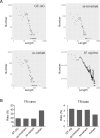Unique features of conventional and nonconventional introns in Euglena gracilis
- PMID: 38872102
- PMCID: PMC11170887
- DOI: 10.1186/s12864-024-10495-9
Unique features of conventional and nonconventional introns in Euglena gracilis
Abstract
Background: Nuclear introns in Euglenida have been understudied. This study aimed to investigate nuclear introns in Euglenida by identifying a large number of introns in Euglena gracilis (E. gracilis), including cis-spliced conventional and nonconventional introns, as well as trans-spliced outrons. We also examined the sequence characteristics of these introns.
Results: A total of 28,337 introns and 11,921 outrons were identified. Conventional and nonconventional introns have distinct splice site features; the former harbour canonical GT/C-AG splice sites, whereas the latter are capable of forming structured motifs with their terminal sequences. We observed that short introns had a preference for canonical GT-AG introns. Notably, conventional introns and outrons in E. gracilis exhibited a distinct cytidine-rich polypyrimidine tract, in contrast to the thymidine-rich tracts observed in other organisms. Furthermore, the SL-RNAs in E. gracilis, as well as in other trans-splicing species, can form a recently discovered motif called the extended U6/5' ss duplex with the respective U6s. We also describe a novel type of alternative splicing pattern in E. gracilis. The tandem repeat sequences of introns in this protist were determined, and their contents were comparable to those in humans.
Conclusions: Our findings highlight the unique features of E. gracilis introns and provide insights into the splicing mechanism of these introns, as well as the genomics and evolution of Euglenida.
Keywords: Extended U6/5' ss duplex; Outron; Polypyrimidine tract; SL-RNA; Splice site.
© 2024. The Author(s).
Conflict of interest statement
The authors declare no competing interests.
Figures







Similar articles
-
U1 small nuclear RNA and spliceosomal introns in Euglena gracilis.Proc Natl Acad Sci U S A. 1999 Feb 2;96(3):852-6. doi: 10.1073/pnas.96.3.852. Proc Natl Acad Sci U S A. 1999. PMID: 9927657 Free PMC article.
-
A New Type of Circular RNA derived from Nonconventional Introns in Nuclear Genes of Euglenids.J Mol Biol. 2021 Feb 5;433(3):166758. doi: 10.1016/j.jmb.2020.166758. Epub 2020 Dec 13. J Mol Biol. 2021. PMID: 33316270
-
Transcriptomic and genomic identification of spliceosomal genes from Euglena gracilis.Acta Biochim Biophys Sin (Shanghai). 2023 Nov 25;55(11):1740-1748. doi: 10.3724/abbs.2023143. Acta Biochim Biophys Sin (Shanghai). 2023. PMID: 37705346 Free PMC article.
-
RNA splicing in lower eukaryotes.Curr Opin Genet Dev. 1992 Oct;2(5):712-9. doi: 10.1016/s0959-437x(05)80131-5. Curr Opin Genet Dev. 1992. PMID: 1333856 Review.
-
Comparative molecular cell biology of phototrophic euglenids and parasitic trypanosomatids sheds light on the ancestor of Euglenozoa.Biol Rev Camb Philos Soc. 2019 Oct;94(5):1701-1721. doi: 10.1111/brv.12523. Epub 2019 May 16. Biol Rev Camb Philos Soc. 2019. PMID: 31095885 Review.
References
MeSH terms
Substances
Grants and funding
LinkOut - more resources
Full Text Sources
Miscellaneous

